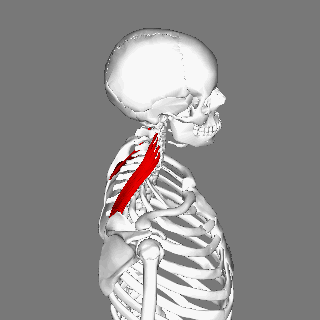Levator Scapulae: Difference between revisions
No edit summary |
No edit summary |
||
| Line 34: | Line 34: | ||
== Assessment == | == Assessment == | ||
The levator scapulae length and tension can be assessed by placing the patient in supine, stabilizing the ipsilateral scapula, and contralateraly side bend and rotate the head. Also, trigger points are common in this muscle and can be palpated for in both the superior attachment and inferior attachment. | The levator scapulae length and tension can be assessed by placing the patient in supine, stabilizing the ipsilateral scapula, and contralateraly side bend and rotate the head. Also, trigger points are common in this muscle and can be palpated for in both the superior attachment and inferior attachment. | ||
{{#ev:youtube|eHttcS_u3SU}} | |||
== Treatment == | == Treatment == | ||
Revision as of 23:01, 4 July 2018
Original Editor - Wendy Walker
Lead Editors - Eric Henderson, SULEIMAN USMAN, Kim Jackson, Lucinda hampton, Admin, Wendy Walker, WikiSysop, Evan Thomas, Oyemi Sillo, Tarina van der Stockt and Joao Costa
Description[edit | edit source]
Levator scapulae connects the upper limb to the vertebral column and lies in the posterior triangle of the neck. The superior aspect of the levator scapulae is covered by sternocleidomastoid, and its inferior part by trapezius.
Origin[edit | edit source]
The levator scapulae originates on the posterior tubercle of transverse process of cervical vertebrae 1 to 4.[1]
Insertion[edit | edit source]
The levator scapulae inserts on to the vertebral margin of the scapula between the superior angle and the root of the spine.[2]
Nerve Supply[edit | edit source]
The levator scapulae is innervated by cervical nerve (C3-C4) and dorsal scapular nerve (C5).[3]
Blood Supply[edit | edit source]
Descending scapular artery[4]
Function[edit | edit source]
The levator scapulae elevates and rotates the scapula.[1] The levator scapulae elevates and rotates the inferior angle medially, when the spine is fixed. When the unilateral shoulder is fixed the levator scapulae rotates the scapulae to the same side and flexes the spine laterally. When bilateral shoulders are fixed the levator scapulae co-contract equally causing a gross flexion/extension of the cervical spine.
Clinical Relevance[edit | edit source]
Forward head posture puts increased tension on the levator scapulae muscles to co-contract for cervical extension in an elongated position. Increased tightness in the levator scapulae due to increased activity from a forward head posture can lead to cervicogenic headaches.
Assessment[edit | edit source]
The levator scapulae length and tension can be assessed by placing the patient in supine, stabilizing the ipsilateral scapula, and contralateraly side bend and rotate the head. Also, trigger points are common in this muscle and can be palpated for in both the superior attachment and inferior attachment.
Treatment[edit | edit source]
References[edit | edit source]
- ↑ 1.0 1.1 http://www.anatomyexpert.com/structure_detail/5502/
- ↑ http://www.wheelessonline.com/ortho/levator_scapula
- ↑ http://www.bartleby.com/107/121.html
- ↑ Joseph P Iannotti, Richard Parker.fckLRThe Netter Collection of Medical Illustrations: Musculoskeletal System, Volume 6, Part I - Upper Limb. Elsevier Health Sciences. 2012







